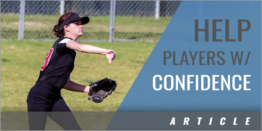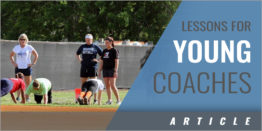| A Sure-Fire Drill to Get Better Fielding Pitchers |
| By: Cindy Bristow
Provided by: Softball Excellence Many pitchers fear balls hit back at them either because they've been hit in the past, or they fear they might get hit in the future. Whatever the reason, here's a drill to help them overcome their fears. Separating the pitching skill from the fielding skill is important for a good fielding pitcher, but not every pitcher can easily do that. At least not without some help. Great pitchers don't consider that they might get hit with a batted ball and instead, they focus solely on making their pitch work. Then if the ball is hit either back at them or near them then they focus on fielding it. The most common drill we use to help our pitchers improve their fielding skills is to have them pitch an imaginary ball while we then hit them a groundball. They can do this drill pretty well and yet they still falter during games. Here's why. This drill is too predictable and too fake. It's fake in that they pitcher isn't really pitching, and if she is, she isn't doing it with the sole focus of making her pitch work to get the batter out - which IS how she must pitch during a game. And it's too predictable because she knows the ball will be hit back at her and that it will most likely be a groundball - which aren't things she can predict in a game. When pitching in a game, pitchers direct their entire focus on the pitch type, location and getting the batter out (the opposite of fake). Then, after the pitch, they quickly change focus to deal with the scenario of the ball being hit. The type of hit is unpredictable and the pitch itself is very real.
But here's a drill that does work, isn't fake and is definitely not predictable. Plus, as long as you have a wall, the pitcher or pitchers can do it by themselves. Here's how it works: • The pitcher has her glove on and a ball. • Pitch #1 - She starts 43 feet (or whatever her pitching distance is) from the wall, and pitches the ball into the wall as hard as she can and then fields the ball. • Pitch #2 - She stays where she is and pitches the ball again, as hard as she normally does (without going back to where she started but instead, she starts Pitch #2 from the place where her stride landed and where she fielded the ball – closer to the wall). • Pitch #3 happens from the place where she fielded the ball & where her stride landed from Pitch #2 • She continues this trying to see how close she can get to the wall and still field or catch the ball. When your pitcher first tries this, she'll no doubt pitch a little cautiously to the wall. While that's normal, it's not helpful since the whole point is to train them to trust their fielding skills while pitching their very best. This drill really works in helping pitchers become much better fielders. I think it has something to do with the pitcher feeling like she's pitching to herself. What's great about this drill is the pitcher will get all kinds of different balls to field - long groundballs, short hops, and line drives - all helping to make her a much more confident and better fielding pitcher! |







